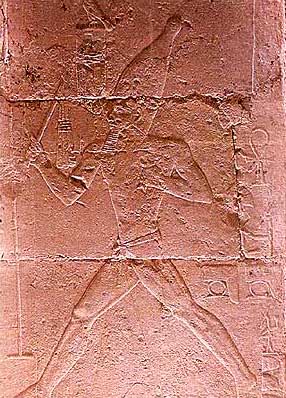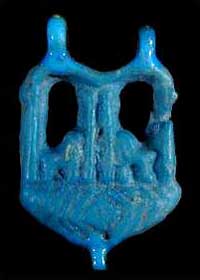The Sed-festival
Renewal of the kings Rule and Health
By Jimmy Dunn

One of the most important festivals related to kingship was the heb sed Festival, also frequently referred to as the royal jubilee or simply the Sed-festival. This significant celebration was a ritual during which the king's right to rule and his royal powers were renewed. There are many representations of this festival, which normally depicts the king running alongside the Apis bull in order to prove his fitness to rule.
A very ancient jackal-like god, who may have been an independent deity or, alternatively, related in some way to the jackal god Wepwawet, was closely related to kingship ideology, and the ancient Sed-festival. Sed was also associated with Ma'at in certain ways and may have been viewed as a champion of justice similar to Ma'at herself.
Usually, this festival officially occurred after the king had held the throne for thirty years, but there is evidence that suggests that some kings, including those with relatively short reigns, celebrated their jubilee earlier. There is some evidence that seems to indicate that the king could, upon failing health or for other reasons, alter the normal span between such festivals, particularly after the first jubilee.
We really do not know the origin of the Sed-festival, though there is some evidence to suggest that it was held from the very beginning of Egypt's recorded history and probably took place even in Predynastic times. The oldest possible example of this Sed-festival is believed to have been found on the decoration of the ritual mace head of Narmer, which is taken by some to be an indication that this king ruled for at least 30 years. However, it is possible that the decoration on this mace head does not represent the Heb Sed at all. What is clear is that evidence form of a small ebony label once attached to a jar of oil from the tomb of King Den at Abydos, on which is depicted a tiny stick-man figure of the king running around a clearly defined course and carrying the heb sed insignia. To the left of the figure is a platform approached by a short flight of steps, on which a double shrine has been erected. The king is once again depicted in the shrine, sitting on a throne and wearing the Double Crown of Upper and Lower Egypt.

The ritual continued to be practiced throughout Egypt's pharaonic history. At Karnak there are blocks from the reconstructed Red Chapel that show queen Hatshepsut as king, running with the Apis bull between the markers. On the inner walls of the hypostyle hall in the Temple of Amun at Karnak, there are also scenes depicting Ramesses II in one of his Jubilees, and the ceremony is also shown in the mortuary temple of Amenhotep III at Thebes. However, this latter king seems to have somewhat altered the ritual and its usual setting . He celebrated three Sed-festivals (years 30, 34 and 37) and descriptions of he ceremonies say that they took place on the great artificial lake he built at Malkata. He seems to have filled his mortuary temple, which was still under construction, with numerous odd animal sculptures that have recently been suggested as forming part of a massive astronomical tableau. Apparently, he and statues of various deities sailed along in barges in order to symbolically recreate the voyage of the sun god through the underworld. However, this also reminds us of a limestone relief now in the Petrie Museum in London that depicts Senusret I celebrating his Sed-festival, holding an oar. An inscription on this artifact reads, "hastening by boat to Min, the god in the midst of the city".

Even during the reign of the 18th Dynasty heretic king, Amenhotep IV (later Akhenaten), the heb sed festival was depicted in the colonnaded court of the Temple of Aten at Karnak. However, in this instance, and perhaps not so surprisingly, his wife Nefertiti and even the royal daughters seem to have taken part in the ceremony. Remarkably, the Aten is also seen taking part in a Sed-festival of its own. Gods were usually seen to give Sed-festivals to the king and were never, outside of these depictions, shown taking part in the ritual themselves. Amenhotep IV seems to be pointing out that because the god is king, so the king is also god. In this instance, the king apparently celebrated the Jubilee very early in his reign, perhaps around year two or three, even before he made the move to his new capital at Akhetaten (Amarna).
The festival continued through the very end of the pharaonic period. This is confirmed by scenes from the Temple of Bastet at Bubastis, where the 22nd Dynasty king, Osorkon II, is sown seated in his heb sed kiosk, wearing the typical robe of for the ceremony. Lasting into the Greek Period, at Kom Ombo, carved reliefs show Ptolemy VIII receiving heb sed symbols from the god Horus.

There is also evidence that the Sed-festival was thought to continue after the physical death of the king. In the Step Pyramid complex of King Djoser at Saqqara, there were provisions for this ceremony to be eternally re-enacted. Within the Great Court are markers that indicated the course the king would have to run. This course may have represented the frontiers of Egypt and symbolized the extent of the king's dominion. The figure of the running king can be seen in the low relief in the chambers below the Southern Tomb and beneath the pyramid. On a beautiful alabaster vase that was discovered in one of the chamber beneath the pyramid is carved a figure of a man with arms upraised, holding aloft a square object, perhaps a canopy, although Jean-Philippe Lauer suggests that it is a platform on which the double shrine and two thrones would have been set up. Decorating the handles of this vase or reliefs of the thrones of the Two Lands. The figures represents the hieroglyph for millions of years and the thrones are those used by the king at his Sed-festival.

One of the best preserved cycles of scenes is preserved from the Sun temple of King Niuserre in Abu Ghurab. The reliefs from the temple are now in different collections, some in the Petrie Museum (see the link below the following pictures). However, while it is tempting to consolidate our understanding of this festival from combined sources such as this and others from all period in order to create a comprehensive explanation for this particular ritual, it is very likely that how it was conducted changed over time, and the nuances of its meaning probably did as well. Yet, several aspects seem to have characterized the Sed-festival more than any other. The typical clothing for the king is was a short cloak which reaches the knees and leaves the shoulders almost free. He sits on a special dais provided with two thrones for an appearance as King of Upper and Lower Egypt. The thrones are normally shown back to back, but this may be an artistic device for rendering a pair which were actually side by side.
More elaborate scenes, later than the Early Dynastic Period, give as the setting for this ceremony a series of shrines pictured as constructions of wood and matting. This form of shrine probably originated as a type of temporary building, and in this context represented another pair of dual symbols, with one design for Lower Egypt and the other for Upper Egypt. Sometimes they were specifically for the cobra-goddess Wadjit of the Delta town of Buto, and the vulture goddess Nekhbet of el-Kab, but they were for other deities as well. There was hence a gathering of provincial images of deities in a series of temporary shrines beside the double throne of the king.
In the open space between the two rows of shrines, the king, attired alternately in the insignia of Upper and Lower Egypt, ran a ritual race around a course which was called "the field". The king would round the boundaries of the field four times as the ruler of Upper Egypt and four times as the ruler of Lower Egypt.
Other ceremonies also took place during the Sed festival, such as the act of homage to the king by the "Great Ones of Upper and Lower Egypt". This festival was also an occasion for the issue of commemorative objects, including stone vases bearing the king's titulature.
References:
| Title | Author | Date | Publisher | Reference Number |
| Akhenaten: King of Egypt | Aldred, Cyril | 1988 | Thames and Hudson Ltd | ISBN 0-500-27621-8 |
| Ancient Egypt (Anatomy of a Civilization) | Kemp, Barry J. | 1989 | Routledge | ISBN 0-415-06346-9 |
| Ancient Gods Speak, The: A Guide to Egyptian Religion | Redford, Donald B. | 2002 | Oxford University Press | ISBN 0-19-515401-0 |
| Atlas of Ancient Egypt | Baines, John; Malek, Jaromir | 1980 | Les Livres De France | None Stated |
| Chronicle of the Pharaohs (The Reign-By-Reign Record of the Rulers and Dynasties of Ancient Egypt) | Clayton, Peter A. | 1994 | Thames and Hudson Ltd | ISBN 0-500-05074-0 |
| Complete Gods and Goddesses of Ancient Egypt, The | Wilkinson, Richard H. | 2003 | Thames & Hudson, LTD | ISBN 0-500-05120-8 |
| Dictionary of Ancient Egypt, The | Shaw, Ian; Nicholson, Paul | 1995 | Harry N. Abrams, Inc., Publishers | ISBN 0-8109-3225-3 |
| Egyptian Museum Cairo | Riesterer, Peter P.; Lambelet, Roswitha | 1980 | Lehnert & Landrock | ISBN 977-243-004-5 |
| Gods and Myths of Ancient Egypt | Armour, Robert A. | 1986 | American University in Cairo Press, The | ISBN 977 424 669 1 |
| History of Ancient Egypt, A | Grimal, Nicolas | 1988 | Blackwell | None Stated |
| Luxor, Karnak and the Theban Temples | Siliotti, Alberto | 2002 | American University In Cairo Press, The | ISBN 977 424 641 1 |
| Monarchs of the Nile | Dodson, Aidan | 1995 | Rubicon Press | ISBN 0-948695-20-x |
| Oxford History of Ancient Egypt, The | Shaw, Ian | 2000 | Oxford University Press | ISBN 0-19-815034-2 |
| Sacred Sites of Ancient Egypt | Oakes, Lorna | 2001 | Lorenz Books | ISBN (non stated) |

